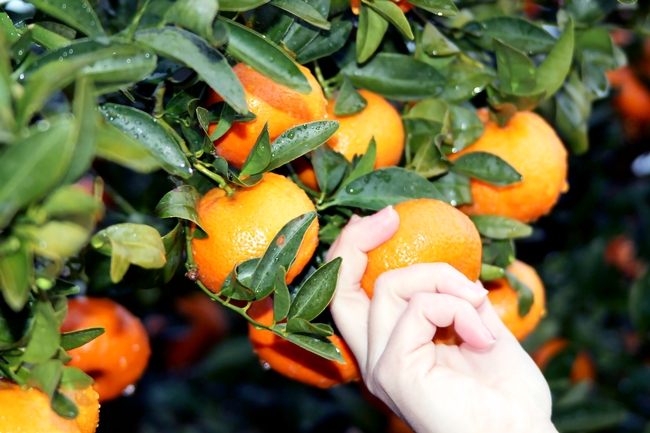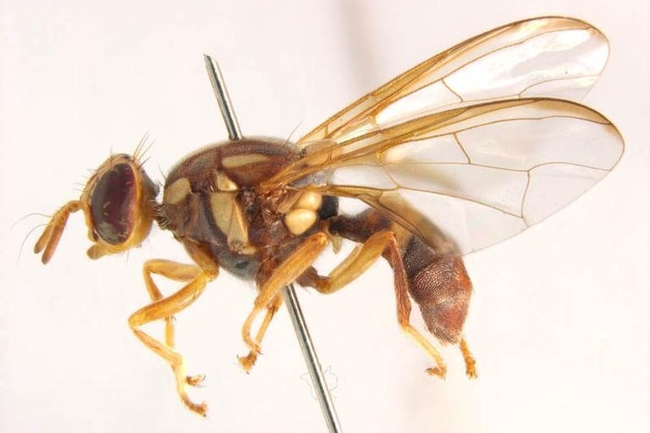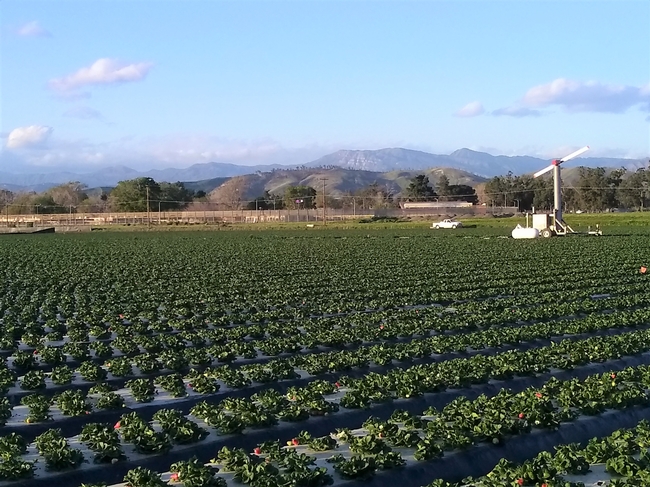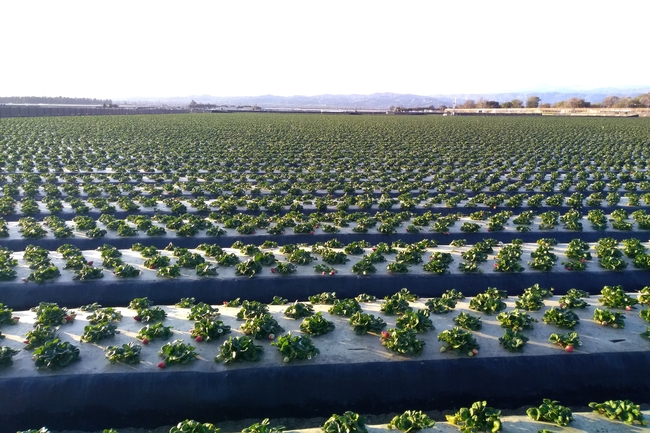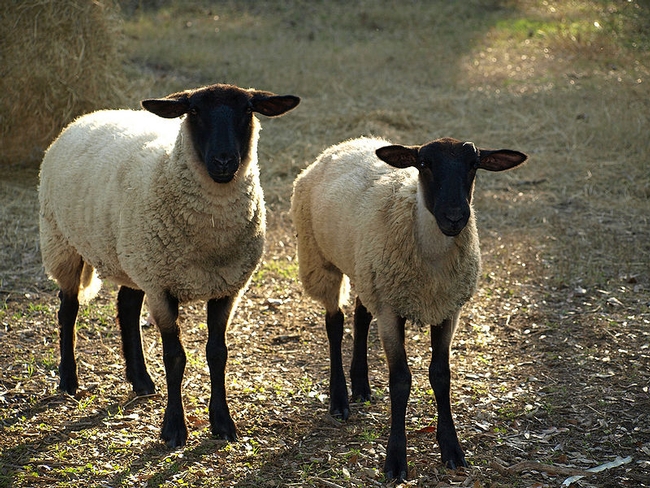While people often gift or share homegrown fruit during the holidays, residents in fruit fly quarantine zones should refrain from moving homegrown citrus or other produce off their property. Photo by Evett Kilmartin
QFF quarantine in LA, Ventura counties among seven fruit fly quarantines statewide
Residents in multiple Southern California and Northern California counties should not move homegrown fruits and vegetables from their properties to help contain several species of fruit fly that can destroy crops and impact the livelihoods of local farmers.
With sharing and gifting of food integral to the holiday season, the California Department of Food and Agriculture is reminding people to heed the seven active fruit fly quarantines aimed at controlling the Mediterranean fruit fly, Oriental fruit fly, Tau fly and Queensland fruit fly. The links below describe quarantine zone boundaries:
People within these zones should consume or process (i.e., juice, freeze or cook) their homegrown fruits and vegetables at the place of origin and not move them off their property. Uneaten produce should be double-bagged in plastic bags and disposed of in the landfill bin – not compost or green waste.
Queensland fruit fly threatens California citrus, other crops
The Queensland fruit fly (Bactrocera tryoni) quarantine is the first of its kind in the U.S. Although QFF was first seen in California in 1985, the recent detection of two adult males triggered the unprecedented quarantine action by USDA's Animal and Plant Health Inspection Service and CDFA.
The highly adaptable Queensland fruit fly has more than 170 host plants, making it a threat to a wide variety of California commodities. Photo: Pest and Diseases Image Library, Bugwood.org; licensed under a Creative Commons Attribution-Noncommercial 3.0 License
“This pest has earned a bad reputation for wreaking havoc on fruit production in Australia, where it is native,” said Hamutahl Cohen, University of California Cooperative Extension entomology advisor for Ventura County. “Adult flies lay their eggs in fruit, and the eggs hatch into larvae that then feed on the fruit, causing damage.”
And while females of other fruit fly species live for only two or three months, QFF females are unique in that they can live up to a year, according to Cohen.
“Once QFF populations take root, they're challenging to manage because females can each lay up to 100 eggs per day,” Cohen said.
In addition to being highly adaptable to a variety of environmental conditions, QFF has more than 170 host plants – including a wide range of California commodities such as citrus, grape, strawberry, fig, avocado, apricot, peach, cherry, nectarine, plum, pear, apple, tomato and sweet pepper.
The threat to citrus is especially concerning, as Southern California growers continue to grapple with the specter of spreading huanglongbing (HLB) disease, which kills citrus trees. Cohen said residents of citrus-growing regions can do their part to help their neighbors and local economy by respecting quarantine restrictions.
“Growers are already dealing with other invasive species like Asian citrus psyllid [vector of HLB pathogen], so we as homeowners need to prevent the spread of fruit flies to reduce the burden on them,” she explained.
While a spike this year in the detections of multiple fruit fly species was likely caused by a host of factors, Cohen speculates that increased post-pandemic travel is helping to move the flies. And with holiday travel in full swing, she said it's important to practice “Don't Pack a Pest” principles.
“Invasive species often hitchhike on fruits and vegetables brought into California by travelers – that's why we often first find invasive species in urban and suburban backyards, and not on farms,” Cohen said. “Travelers entering the U.S. can visit dontpackapest.com to learn about which products they can and cannot bring back with them.”
To report a suspected infestation of fruit fly larvae in homegrown produce, call the CDFA pest hotline at 1-800-491-1899. Growers with questions and concerns are urged to contact their local agricultural commissioner's office.
Posted on
Tuesday, November 21, 2023 at
7:55 AM
Tags:
APHIS (0),
CDFA (0),
fruit fly (0),
Hamutahl Cohen (0),
Los Angeles County (0),
Mediterranean fruit fly (0),
Oriental fruit fly (0),
QFF (0),
quarantine (0),
Queensland fruit fly (0),
Tau fly (0),
Ventura County (0)
Focus Area Tags: Agriculture, Food, Pest Management
In December 2022, the UC acquired a 114-acre farm property in Camarillo to serve as the new home of UC ANR's Hansen Research and Extension Center. Photo by Annemiek Schilder
UC Hansen Research and Extension Center to expand capacity at Camarillo location
The University of California Hansen Agricultural Research and Extension Center – the site of popular school field trips, 4-H programs, a UC Master Gardener demonstration garden, and numerous research trials on crops and landscape plants – is moving to a new location on the west side of Camarillo. The center was established through an endowment bequeathed to the UC by Saticoy farmer Thelma Hansen, who sought to support university research and extension activities benefiting Ventura County.
For the past 25 years, Hansen REC has been located on the historic Faulkner Farm in Santa Paula. At 27 acres, Hansen REC was the smallest of the nine RECs across the state operated by UC Agriculture and Natural Resources; in 2019, UC ANR leadership decided a larger property was needed to expand the center's capacity. The Faulkner Farm was sold in March 2021, but a portion was leased back to the UC to sustain its programs until a new location was identified.
The new Hansen REC site, located on the Oxnard Plain, is conducive to research on Ventura County's high-value crops, such as strawberries. Photo by Annemiek Schilder
In December 2022, the UC acquired a 114-acre farm property in Camarillo to serve as Hansen REC's new home. Moving structures and equipment from Faulkner Farm will take place over the next six months. Public programs at the new location are on hold until seismic retrofitting and other building upgrades are completed. A new research and educational facility also will be built, with an estimated opening date in 2027 or 2028.
“Our planning committee looked for a site on the Oxnard Plain that is representative of the coastal agriculture environment and conducive to research on Ventura County's high-value crops, such as strawberries,” said Annemiek Schilder, Hansen REC director. “We also sought a location with diverse soil types, access to sufficient irrigation water, and a low risk of flooding – and we're pleased that this Camarillo property meets most of our search criteria.”
Of the approximately 104 cultivable acres, 28 are certified organic, which will allow researchers to study organic as well as conventional crop production methods, Schilder noted. She said another bonus of the new location is its proximity to California State University, Channel Islands and the Rodale Institute California Organic Center, which are both potential partners for future research and a student organic farm on site.
Initial plans for the new Hansen REC facility include offices, conference rooms, laboratories, greenhouses, a demonstration kitchen, and indoor and outdoor education areas. The center will aim to be water-efficient and energy-neutral, relying on solar panels for much of its energy usage. The UC Cooperative Extension Office in Ventura is also slated to move to the new facility.
“We fully expect Hansen REC to become a vibrant research and education hub that provides science-based solutions and is responsive to the needs of agricultural, rural and urban communities and the environment in Ventura County,” said Glenda Humiston, UC vice president for agriculture and natural resources. “We're excited to expand current programming while bringing in new educational opportunities, such as the UC Master Food Preserver and Master Beekeeper programs.”
Posted on
Wednesday, February 15, 2023 at
1:27 PM
Tags:
4-H (105),
Annemiek Schilder (5),
Glenda Humiston (47),
Hansen (3),
Hansen REC (1),
HAREC (1),
Master Beekeeper (1),
Master Food Preserver (18),
REC (4),
Research and Extension Center (2),
UC Master Gardener (7),
VC (1),
Ventura (1),
Ventura County (8)
Focus Area Tags: 4-H, Agriculture, Food, Yard & Garden
In 4-H animal science projects, youth learn about animals and their behavior, health and reproduction.
Eleven-year-old Demisu Evans of Ojai will get a new custom-made wheelchair after raising a sheep and selling it at the Ventura County Fair, reported Anne Kallas in the
Ventura County Star.
4-H, offered in all California counties by UC Cooperative Extension, engages youth ages 5 to 19 in reaching their fullest potential. Club and after-school programs are designed to provide knowledge, expertise and skills that will help youth develop into responsible, self-directed, and productive people. 4-H encourages family involvement.
The Ventura County Star's heart-warming story traces Demisu's journey from his native Ethiopia to a ranch in rural Upper Ojai. One of 10 children, three adopted from the west African nation, Demisu has triplegia, the use of only his right arm. The rocky and uneven terrain at the family's ranch made it difficult for Demisu to get around, so he decided to raise funds for a heavy-duty wheelchair that he can operate with one hand. The cost is $6,000.
Demisu raised a 113-pound lamb, and sold it for $75 a pound to the Wood-Claeyssens Foundation. At market, sheep are typically valued at about $1 to $2 per pound, according to Sheep101.com. Bidding for Demisu's sheep went through the roof when bidders learned he would be using the money for the new, custom wheelchair.
Posted on
Monday, August 29, 2016 at
9:46 AM
'It is so amazing to see their eyes light up and hear the excitement in their voices when they see the work of their hands.' - Ventura County teacher
This is a real testimonial about the value of a school garden. I received an email recently from a teacher at a school where our University of California Cooperative Extension team installed garden beds this last school year. I have made minimal edits to the email to protect the privacy of the students. The program is the Middle School Opportunity Program at
Foothill Technology High School in Ventura Unified School District. (This is an innovative and targeted program at one of the nation's highest achieving public high schools. Foothill was just ranked by Newsweek magazine in its top 100 public high schools, as #77 among all high schools, and #54 nationwide at effectiveness in serving low-income students).
At the end of a challenging day, I found this in my inbox:
“Our garden continues to thrive! My students love it. They run over to it first thing each morning to check the progress of their plants. Right now we have the last of our tomatoes, the last of the strawberries, bell peppers, snacking peppers, cucumber vines that are flowering, pumpkin vines (we planted those late), radishes, cilantro, chives, corn, and broccoli (something is eating the leaves. Ideas?). I am teaching plant science and it has been so wonderful to use our garden plants for examples. It makes the lessons so much richer.
The kids have asked me if we can install two more planter boxes. I told them I would check with you to see if you have more. If not, we will make them ourselves.
Again, thanks so much for getting us started last year. The addition of our garden has made our program more enjoyable for the students and for me. It is so amazing to see their eyes light up and hear the excitement in their voices when they see the work of their hands actually thriving!”
Over one hundred years ago, Ventura Unified teacher Zilda Rogers also gardened with her students, and also wrote to a University of California staff member about the positive experiences her students were having in their school garden. This important story about the history of school gardens appears in a book I recently published, called “Sowing the Seeds of Victory: American Gardening Programs of World War I.”
History often repeats itself. And sometimes, in good ways. P.S. to one of my favorite teachers, at one of my favorite schools, in one of my favorite school districts: We'll be over ASAP to fulfill your request for two more garden boxes to expand this “growing” enterprise!
“A Garden for Everyone. Everyone in a Garden.”
Posted on
Saturday, October 18, 2014 at
3:24 PM
A panel discusses the future of agriculture in California.
There are many issues facing Ventura County farmers that UC Cooperative Extension is working to resolve, according to presentations yesterday at an event celebrating UCCE's first 100 years of science and service. The event was covered by reporter Carol Lawrence of the
Ventura County Star.
At the event, UCCE advisors talked about the status of ag industry in Ventura County, where total farm production is nearly $2 billion annually. Strawberries, the county's leading crop since the early 2000s, are valued at $690 million. However, production is threatened by dwindling water supplies.
"We can't avoid this topic," said Oleg Daugovish, UCCE advisor.
UCCE advisor Ben Faber also discussed the water situation. The average annual rainfall in Oxnard was 17 inches between 2003 and 2008.
"We're living in an environment that rarely sees the average rainfall," Faber said.
Faber's work includes showing growers how using too much or too little water is more likely to cause plant disease and demonstrating new ways of measuring the water content in soil, the article said. One solution to water woes is using recycled water in nurseries. The practice saves 14 to 42 percent of water.
UCCE advisor Jim Downer talked about the movement of exotic pests that are a potential challenge to agriculture. California is particularly vulnerable to these pests because of its vast and varying geography and climate, he said.

Ventura County's top 10 ag commodities were on dispaly in a Model T truck at the UC Cooperative Extension Celebration of Science and Service.
Posted on
Thursday, January 30, 2014 at
11:00 AM

